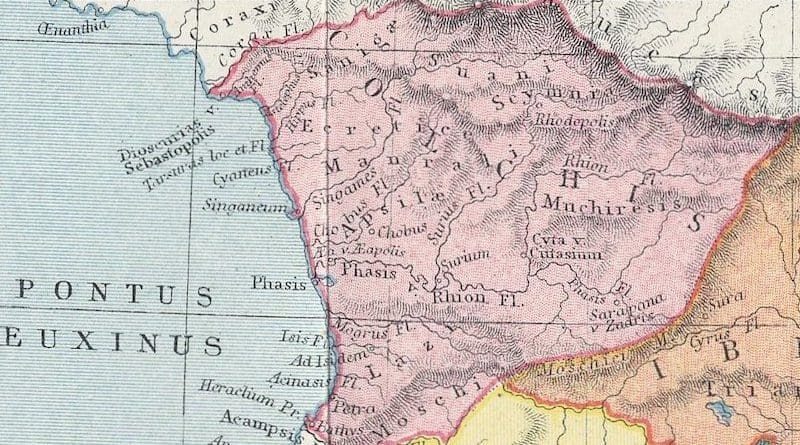From The North Black Sea Coast To Georgia: Political Emigrants In The Past And Present – Essay
By Prof. Dr. Tedo Dundua and Dr. Emil Avdaliani
The Crimean Peninsula and most of the eastern parts of Ukraine are currently occupied by Russia. Georgia serves as a host country to numerous emigrants from Ukraine. An identical case is discussed below, how in Antiquity emigrants from Crimea moved to Western Georgia/Colchis.
We focus here on small size copper, billon, and silver coins, eight samples in all (so-called Saulaces’ coins).
I type
Obverse: Male head to the right in the radiant crown.
Reverse: Bull’s head to the right. Greek inscription above and below, meaning “of king Saulaces”, or “Saumakos“. The king’s name is only partially inscribed with the last letter read either “L”, or “M”.
II type
Obv.Male head to the right in the radiant crown.
Rev. Rose, Greek inscription above and below, meaning “of king Saulaces”, or “Saumakos”.
III type
Obv.Male head facing in radiant crown.
Rev. Winged thunderbolt with identical Greek inscription above and below.
As we see, none of the coins has a full inscription of the king’s name. This fact generated discussions lasting for more than a century. Doubtful is the fourth letter of the king’s name on the reverse of the coin. Some scholars read it as “L”, and therefore, the inscription is deciphered as “of king Saulaces”, since the latter name appears among the names of the Colchian kings.
Other scholars, however, read the fourth letter as “M”. Thus, according to this group of scholars, the name on the coin should be read as “of king Saumakos”, since such a king is known in the history of the kingdom of Bosphorus (in Eastern Crimea).
On the II type of these coins a rose is depicted, which allows us to date approximately the whole coin group. This type is taken from the Rhodean numismatics. The rose-depicted coin is the exact copy of those Rhodean coins struck in 166-88 B.C. This, in turn, allows us to date those discussed samples by 2nd-1st cc. B.C.
The fact is that 5 samples out of 8 were found in Western Georgia (near Sokhumi and in Vani).
Some scholars relate the above-given coins to the kingdom of Bosphorus. Their argument is as follows: as was mentioned above, rose type is taken from the Rhodean money, struck in 166-88 B.C. Thus, these coins should be dated by 2nd-1st cc. B.C. The only historical figure attested by the written sources is Saumakos. He is mentioned in the decree set up in Chersonesus (in Southwestern Crimea) in honor of Diophantos (general of Mithridates VI Eupator, king of Pontus (120-63 B.C.)). Saumakos organized a coup d’état in the kingdom of Bosphorus in the last decade of the 2nd c. B.C. and reigned over it for a short period of time. Presumably, he struck these coins during this period. In 107 B.C. he was defeated and taken prisoner by the above-mentioned Diophantos. Considering the given facts, these coins can be attributed to the numismatics of the kingdom of Bosphorus. Very likely, they were brought to Colchis by the supporters of Saumakos, who had to leave the country, i.e. by political emigrants.
Prof. Dr. Tedo Dundua, Dr. Emil Avdaliani, Ivane Javakhishvili Tbilisi State University, Georgia




